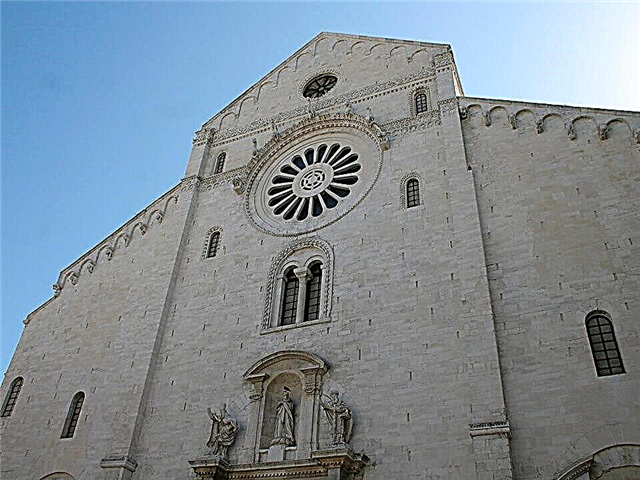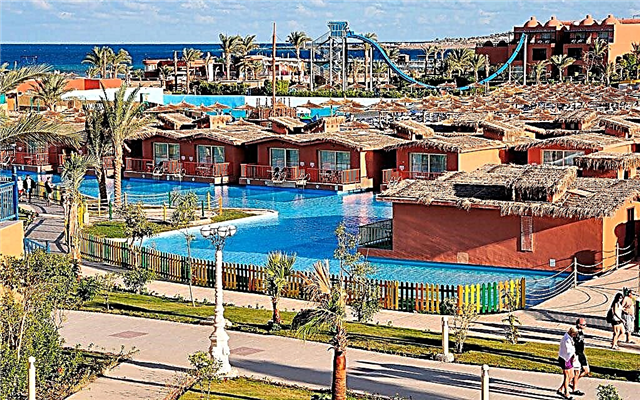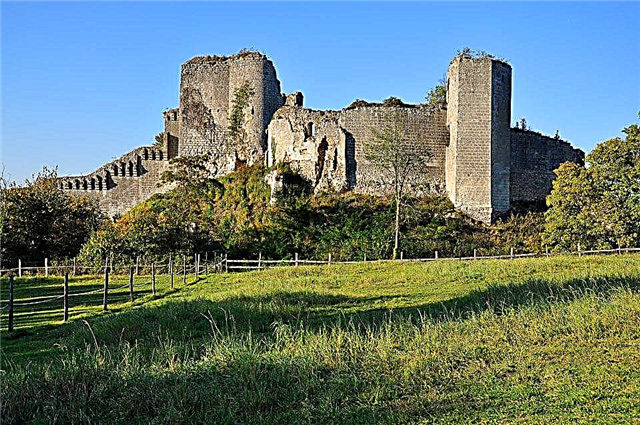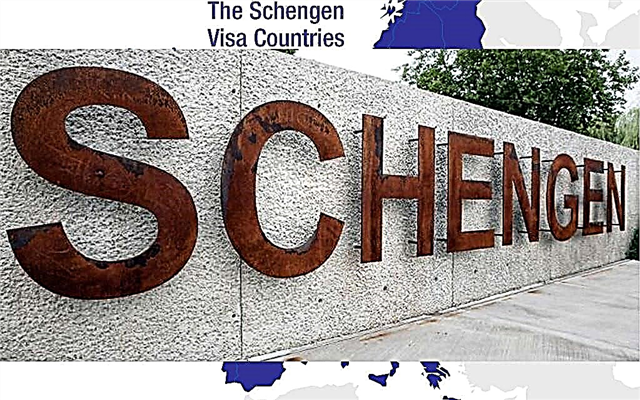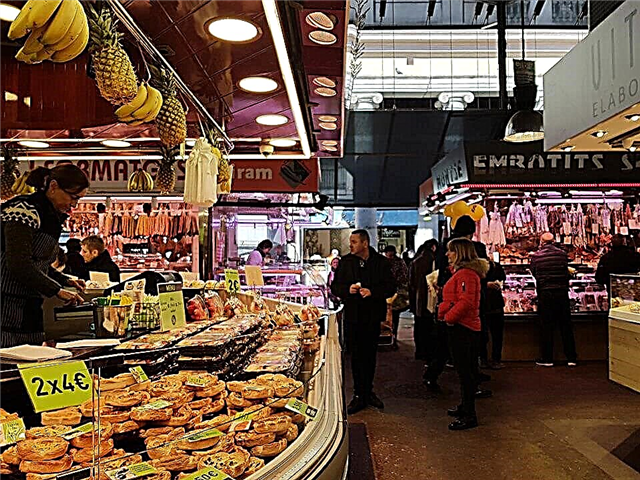When there is very little time, it is very difficult to feel the atmosphere of a European city, get acquainted with its features and examine it in detail. But if it doesn't work out otherwise, and your next stop is Barcelona, then we will try to help you somehow by developing an interesting and rich walking route. We promise that this day will be remembered for a lifetime, and next time you will certainly want to spend much more time here. So, let's tell you what to see in Barcelona in one day on your own.
Mila's house

The wavy, eccentric building reflects the style and hand of the Spanish architect Antoni Gaudí, who was popular with the upper strata of society and regularly received orders from them. Gaudi himself has admitted more than once that all his creations are inspired by nature - Casa Mila is like a sheer rock washed by the waves of a raging sea, and the fence on the balconies is made of iron rods, reminiscent of algae intertwined with water.
The house has almost no strict straight lines and supporting structures, for which the locals call it "drunken house". Once the entire building was built for the wealthy family of magnates Pere Mila y Caps, but today it houses a bank, several residential apartments and a museum. Most of the museum's exhibits represent Gaudi's personal belongings, which he was inspired by and used in his drawings, as well as interior items of the 20th century.
For that time, Mila's house was very extravagant and incomprehensible, but decades later, the architect's work was appreciated and even included in the UNESCO World Heritage List. You can listen to the history of the house using the audio guide in Russian. The ticket price for children is 11 euros, for students - 16.5 euros, and for adults - 22 euros. In winter, it is open from 9:00 to 18:30, in autumn from 9:00 to 20:00, on holidays - from 9:00 to 14:00.
Casa Batlló

Batlló is one of the most amazing buildings in the entire world. The history of the creation of this masterpiece began in the same way as with the rest of the buildings of Antoni Gaudi: a wealthy Spanish entrepreneur decided to surpass in luxury and decoration the neighboring house of Amalier in the neo-Gothic and Art Nouveau style and, it seems, knew whom to turn to.
In just 2 years, the facade of the building, devoid of symmetry, was overgrown with multi-colored mosaics and human bones, and the roof of the building with the tower on it looked like dragon scales, which, by the way, shimmers in the sun with all the colors of the rainbow. Despite the seemingly frightening elements of the skulls framed by balconies and columns, Batlló, on the contrary, looks attractive and fabulous.
If in the previous architectural monument, marine motifs can be traced, then here Gaudi, in a team with other talented craftsmen, embodied the myth of the victory of St. George over the dragon, and then we can conclude that the bones belong to the victims of the monster, and the tower with the cross is a kind of sword that has sunk into his back. You can visit the "House of Bones" daily from 9:00 to 21:00 for 21.5 euros for pensioners, students and children from 7 to 18 years old, the rest will have to pay 24.5 euros. Tickets at the box office will cost 4 euros more.
Plaza Catalunya

The center is the source of nine famous shopping streets, which is a square in the form of the sun and rays emanating from it. Life around the local landmark is in full swing 24 hours a day: the metro runs here; the hum of buses and cars does not subside until nightfall; from boutiques around the square, crowds of locals and tourists come here to take a break, feed pigeons, take photographs against the backdrop of monumental sculptures and fountains, and taste Catalan cuisine. In winter, this place is flooded with an ice rink, and in autumn there are national holidays with performances.
Modern Art Museum

A huge building with many Art Nouveau windows can be seen from afar. Since the museum opened in 1955, its owners have been collecting works that represent not only Spanish art, but also foreign art from the 1940-1970s. There are so many exhibits that a couple of neighboring buildings, smaller than the main one, had to be allocated for it. They host exhibitions of contemporary authors and house a library.
There is a huge square between the buildings - a favorite place for skateboarders, which, by the way, is recognized as one of the best in all of Europe for this purpose. On weekdays, the museum is open from 11:00 to 19:30, on weekends - from 10:00 to 21:00, on holidays - from 10:00 to 15:00, and on Tuesdays it is closed at all. The ticket price is 14 euros, the entrance is free for seniors and children under 14 years old.
Guell Palace

Another work of Gaudí, included in the UNESCO list, from which the architect began to develop his own unique style. The politician and philanthropist Guell was a friend of Antonio and could only trust him to make his dreams come true. After 5 years, he received a pretentious and unique palace of gray marble, the equal of which has not been found to this day.
The lower part of the building is decorated with Gothic wrought-iron gates, many windows and balconies, the gratings on which are intertwined, forming symbols of hell; while the middle of the palace is made in a rather austere style with no frills, demonstrating the fusion of earth and sky. And on the roof there are chimney towers, stretching towards the sky and the gods, covered with mosaics of the brightest colors.
The interior decoration is also noteworthy - candelabra along the flight of stairs, red carpets, marble columns and furniture with ivory inlaid cost a lot of money for Guell, and even attracted the attention of King Umberto I of Spain himself. Children under 10 can visit the palace-museum for free, and for the rest, the ticket will cost 9-12 euros. Opening hours: 10:00 - 20:00 (April to October) and 10:00 - 17:30 (November to January).
Sagrada Familia

The best work of Antonio Gaudi, he gave her several years of his life, and did not have time to finish. Construction continues today, but the townspeople are in no hurry - in Spain there is a legend about the end of the World, which will come at the end of this project. The temple consists of three buildings, personifying the birth, death and resurrection of Christ, and above each of them there are four spiers, corresponding to the 12 apostles.
The main tower, 170 meters high, is a symbol of Jesus, and even it is worked out in the smallest detail. Despite the surprise of the workers about the uselessness of decorations at such a height, Gaudi continued to stand firm and was going to embody the entire New Testament on the facade of the building. Religious scenes and rituals from the Bible with full-length statues of saints, bas-reliefs, windows, stained glass windows, arches, columns and stairs did not leave a single flat spot on the walls of the cathedral, which now looks more like an anthill.
Surprisingly, such an abundance of outdoor decorations does not press and reduce the space, but on the contrary, it is very spacious there. You can visit this wonder of the world every day from 9:00 to 18:00, and on weekends and holidays until 14:00. The ticket costs 15-20 euros, depending on the presence of the guide on your excursion.
Park Guell

Once the well-known entrepreneur Guell decided to once again invest the accumulated funds in real estate in an ecologically clean area far from the noisy city and construction sites, but in harmony with nature. He relied on the uncommonness of the building and turned to his longtime friend Gaudí. However, after the architect's hard work for 14 years, plans to enrich himself have failed miserably. The Spanish rich did not appreciate the “gingerbread house” style, which was too bold for that time, and it passed into the power of the state.
Even today, the kingdom, as if descended from the pages of fairy-tale books, no one could surpass in extravagance.As always, you will not find straight lines and austere walls near colorful mansions, fences are decorated with battlements, bones, broken glass and colorful mosaics. The interior rooms are breathtaking with the jewelery work of the craftsmen who have adorned the curved, sometimes convex ceiling with hundreds of small medallions of iridescent colors that resemble the back of a salamander.
Columns, benches in the form of curving snakes, viaducts, an unusual landscape with exotic plants, observation decks, museums and souvenir shops - this is not a complete list of everything that can be seen here. Part of the park can be visited free of charge, while tickets to other areas cost 8 euros for adults and 6 euros for children. During the cold season, the park is open from 8:30 to 18:30, in the spring from 8:00 to 20:30, and in the summer from 8:00 to 21:30.
Columbus monument

This monument is located in many cities of Spain, and each of them is ready to prove that it was in their city that Columbus was born and lived. A group of sculptors and artists-engineers reacted very seriously to the sights revered by the Barcelona people, and after 7 years a 60-meter column rose above Barcelona. At the base of the monument there is a passage where the elevator is located - it takes tourists to the observation deck "at the feet" of the navigator.
Much attention has been paid to the statues at the foot of the statue - everyone who was involved in the discoveries of Columbus is captured here forever. These are the Catalan rulers who equipped him for the expedition; and the team, without which he probably would not have been able to succeed; and gods symbolizing victory. You don't take money to view the sculpture, but you need to pay 2 euros for a beautiful bird's-eye view.
Sea port
For 2000 years the port has been receiving cruise liners, fishing and merchant ships. The huge square near its building serves as a place for walks and meetings of the Spaniards, and in its center there is a monument to Christopher Columbus. From here there are roads to La Rambla, the Grand Market, Avenue Columbus, the Museum of the History of Catalonia and the beautiful wave-shaped bridge that leads to Europe's largest oceanarium and shopping centers. And along the embankment there are luxury yachts, street cafes and souvenir shops.
La Rambla

Pedestrian kilometer street, a must on the list for tourists. It connects five boulevards, each of which has its own peculiarity. On one of them there is a fountain where coins are thrown; the second is a gathering place for Barça fans; on the third, you can buy seeds of exotic plants as a gift to relatives, summer residents; the fourth one offers national snacks and sweets; and the fifth is represented by the opera house.
Within walking distance of La Rambla are the Plaza del Os and the intricate, unusual Umbrella House. Street performers, mimes, magicians, living statues and simply mummers from history or modern films are especially magnificent here. At every turn, mouth-watering signs attract pizzerias and European restaurants, but food, souvenirs and things on La Rambla are 2-3 times more expensive than everywhere else.
Boqueria market

You can't find a more colorful place than Boqueria. All trade pavilions are decorated as if they were preparing for a food fair. Vendors love their craft and arrange fruits and vegetables in such a way that it is impossible to pass by the variegated variety and not buy at least a kilogram of ripe tomatoes or juicy oranges arranged in a pyramid.
Fruit platter or smoothies from them are sold at every corner for 1-2 euros per serving. The next rows are reserved for the freshest seafood that can be cooked for you on the spot, for example, a portion of shrimp in batter costs 4-6 euros. And of course, the sausages (chorizo from 2 euros per stick) and jamon (from 50 euros per pound) section is considered the most popular area on the market. Bright red bunches of paprika, garlic and mushrooms hang from almost all the counters, while jars of spices, olives and oil can be seen on the back shelves.
In order not to leave here half of your accumulated funds for rest (as local merchants skillfully entice a whole pork leg to buy at once), the guides offer a culinary tour of Boqueria for 15-70 euros, which includes a tasting and a lesson from the chef. Officially, the market is open from 8:00 to 20:30, but if the goods are sold out earlier, the tents are closed, so it's better to get here before 16:00.
Gothic Quarter

Many buildings, built almost end-to-end, are made in medieval Gothic style and date back to the 15th century, but these are not just former settlements of Roman soldiers, but a whole treasury of valuable historical monuments. Above the narrow dark streets almost at every step, the impressive size of the operating churches and basilicas rise. It is imperative to set aside time for a photo on the laced Bridge of Sighs, which connects the two parts of the residence of the President of Catalonia.
For 7 euros, you can take a tour of the historical museum in the same quarter and go down to the ruins of the Roman Empire. Exploring the Gothic Quarter will take a lot of time, after which you will need to rest and the Royal Square with fountains and palm trees will give you such an opportunity - the bars are open until late at night. Among the cultural entertainment, the most popular are the gallery of modern art and the Salvador Dali exhibition.
National Art Museum of Catalonia
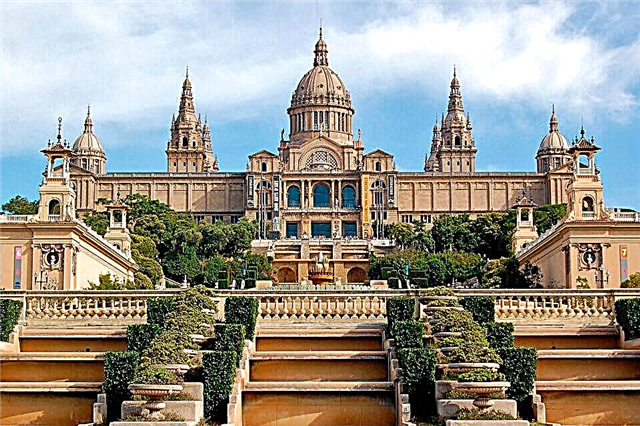
In the National Palace from Tuesday to Saturday from 10:00 to 19:00 a museum of Romanesque art of the 19th and 20th centuries opens its doors. Its sections are dedicated to photographs, drawings, antique coins and medals, books, exclusive furniture from Antoni Gaudí, wall paintings and paintings by famous artists, including Picasso and Dali.
The entrance to the museum is represented by a huge wide staircase, in the center of which a fountain falls like a waterfall, and trimmed bushes and trees are planted on the sides. On weekends, sometimes there is free admission, children under 16 and pensioners also do not need to pay, and for everyone else the ticket price is 12 euros.
Magic Fountain of Montjuic

When all the attractions run out of business and have nowhere else to go, the Singing Fountain of Carlos Buigas kicks off its show at nightfall. More than 3,620 jets of Montjuic automatically adjust the water pressure to the rhythm of romantic musical compositions. To implement such a project, it took a whole year and about 3,000 workers, and at first the fountain was manually controlled by a whole team of people. The performance takes place every half hour from 21:00 to 23:00 from Thursday to Sunday (May-October) and from 19:00 to 21:00 on Fridays and Saturdays (October-May). For convenience, viewing platforms and cafes have been created around the fountain, open until midnight.
Triumphal Arch

The Roman custom of erecting an arch in memory of significant events was passed on to many countries, and Spain was no exception. For the opening of the World Exhibition in 1888, Jusepe Vilaseche created a magnificent masterpiece that surpasses similar buildings in neighboring estates. The classic style of a red brick arch combined with gray stone looks simple but tasteful.
Numerous bas-reliefs depicting the achievements of Barcelona serve as decorations, as well as sculptures that depict the process of welcoming and rewarding guests. A 30-meter arch serves as the entrance to the Citadel Park, where it is pleasant to walk in cold weather. And not far from the arch there is a zoological museum, a park and several curious castles.
Hola BCN: public ticket transport for 2,3,4 or 5 days
Ticket to PortAventura park and transfer - 69 €
Ticket to the parks "PortAventura" and "Ferrari Land" - 55 €
Tibidabo amusement park ticket - 28.50 €
1 or 2 days hop-on hop-off Barcelona city tour - 30 €
How and what to save on
Everyone knows that Barcelona is an expensive city. If there is an opportunity to save money, why not use it?
- Skip-the-line tickets to the Sagrada Familia and Park Guell
- Transfer from and to the airport
- Hop-On Hop-jff bus tickets for 1 or 2 days
- Tickets to top museums, attractions (including Casa Mila, Casa Batlló and Camp Nou), excursions and bike tours
- Hola BCN public transport ticket for 2, 3, 4 or 5 days
Priority entry tickets will save you time and avoid long queues.
How to get from the airport to the center
So, you have arrived in the city, which means you need to get from the airport to the city and here our life hack will come in handy. If your arrival airport is El Prat, then you are in luck, the city is only 10 km away. The RENFE train will help you overcome this distance. Sit down and go to Passeig de Gracia station or, if you are closer to getting to the hotel from the train station, then get off at Sants Estaci (Sants Estacio). You can also get from El Prat airport to the city by buying a ticket for the Aerobus bus, the route of which passes through Placa de Catalunya (Plaza Catalunya) and Placa Espanya (Plaza de Espanya). You can choose the stop yourself. Also, bus number 46 will take you to Placa Espanya. If you arrive at night in the capital of Catalonia, you can get to the city by bus number 17.
If your plane landed at Girona airport (Girona), then to get to the city you will have to cover a distance of over 90 km. But today, distances are not a problem, and since you are in Spain, then you know this from your own experience. From the airport to the bus station Estacion del Nord (Estacio del Nord) can be reached in over an hour by bus, which belongs to the Barselona Bus company. By the way, this is practically the very center. So you are lucky to see the famous Arc de Triomphe right away.
Now let's dwell on tickets in more detail. After you get to the station, we recommend that you do not postpone the question of purchasing them. Go down the subway. Here you can buy a T10 ticket, which is designed for 10 trips on all types of public transport. We buy a ticket only for zone 1 (historical center).





